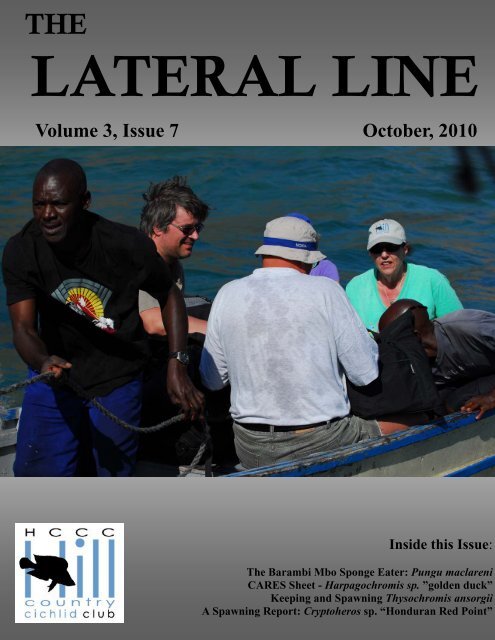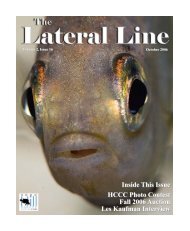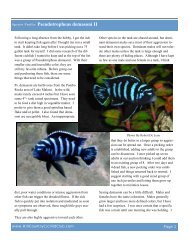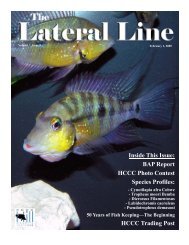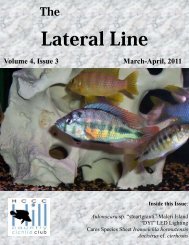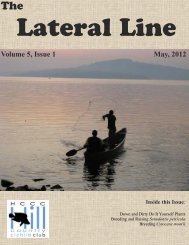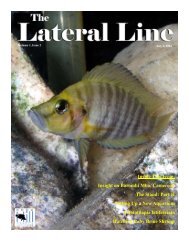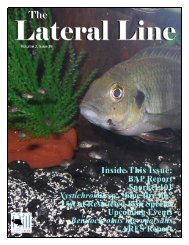Lateral Line October 2010 - Hill Country Cichlid Club
Lateral Line October 2010 - Hill Country Cichlid Club
Lateral Line October 2010 - Hill Country Cichlid Club
- No tags were found...
Create successful ePaper yourself
Turn your PDF publications into a flip-book with our unique Google optimized e-Paper software.
THELATERAL LINEVolume 3, Issue 7 <strong>October</strong>, <strong>2010</strong>Inside this Issue:The Barambi Mbo Sponge Eater: Pungu maclareniCARES Sheet - Harpagochromis sp. ”golden duck”Keeping and Spawning Thysochromis ansorgiiA Spawning Report: Cryptoheros sp. “Honduran Red Point”
2ContentsThe Barambi Mbo Sponge Eater Pungu maclareni (Trewavas 1962) by Troy Veltrop 4Keeping and Spawning Thysochromis ansorgii by Dr. Keith Arnold 10A Spawning Report: Cryptoheros sp. “Honduran Red Point” by Benjamin L. Smith 12Upcoming Events 17On the Cover: Pam Chin, a great friend of the HCCC, made a return trip to Lake Malawi thisautumn. If you look at her cap you will see that she is busy promoting our club all around theworld! Thanks Pam for all that you do! Cover photo courtesy of Larry Johnson.EditorialWhat an incredible run of weather we’vehad! It’s so nice to be able to sleep with thewindows open again. I love this small windowwe get in the fall and spring.We had our fall auction at a new locationearlier this month. The facility was excellent.If offers more room than we are use toas well as convenient location and a kitchenarea. I think after we get a couple events inhere that our turnout will be great.The annual Christmas party is just aroundthe corner. We are aiming for the first Saturdayof December and still trying to solidifya location. Keep an eye on the HCCCforum’s Members Section for more information.Dr. Michael Kidd will be speaking onMalawian cichlids including video footageof his trips there. He is a fantastic speakerand someone you don’t want to miss.The big club news of course centers aroundour 2011 convention FOTAS CARES. Seethe flyer on the following page for a listingof speakers! Expect the hotel location to belocked in by Christmas.We have a new FOTAS President. HCCCmember Charles Jones is now heading theFederation of Texas Aquarium Societies. Iam part of the support crew and will assistCharles in my role of Vice President. YourThe HCCC is a proud member ofthe Federation of AmericanAquarium Societies.HCCC FOTAS rep is Diane Tennison. Youmay come to any of us with any queriesabout FOTAS that you might have.This issue of the <strong>Lateral</strong> <strong>Line</strong> contains aninformative account of the CARES speciesPungu maclareni by Troy Veltrop, our CA-RES chairman. Troy has an impressive collectionof cichlids and I can only hope thatthis will be the first of many great articlesfeaturing his fish.Benjamin Smith shares his experiences withCryptoheros sp. “Honduran red point”.Benjamin has been a prolific contributor tothe pages of the <strong>Lateral</strong> <strong>Line</strong> with qualityarticles. I really appreciate his submissionsbecause, as editor, I realize most of his articlescould easily be appearing in any aquariummagazine.Finally, Keith Arnold, long time Texasaquatic legend, reports on a cool West Africansnail eating cichlid Thysochromis ansorgii.This species was one of those cool auctionfinds that he found success with. That’sall for now, see you next month.
4The Barambi Mbo Sponge EaterPungu maclareni (Trewavas 1962)-Troy VeltropReprinted from Buntbarsche Bulletin, official publication of the American <strong>Cichlid</strong> Association, Inc. (ACA).A close up shot showing the specialized teeth of Pungu maclareni. Photo by Dave Hansen.The Way of the Dodo?Extinction: “To go the way of the dodo,” asthey say. Fighting extinction is the woefulplight of too many of our beloved cichlids.A quandary that can, more often than not, beattributed to the species Homo sapiens andour unsustainable use of natural resources,before it can be attributed to natural causes.One tiny crater lake, Barombi Mbo, in WesternCameroon is home to eleven species ofcichlids that mankind has put in this dilemma.Eleven! All of them are endemic tothis lake. There is also a great deal of otheraquatic life that is endemic to the lake, rangingfrom freshwater sponges to a mudfishnamed Clarias maclareni. The only place inthe world where these species are found inthe wild is in this lake, Barombi Mbo, and itis at risk along with its inhabitants. Conservationof the lake is, of course, paramount,but you are the cichlids’ only chance at survivalif the conservation efforts at the lakeshould fail. Since there are not a great dealof conservation efforts underway at the lake,and the situation will likely worsen before itgets better, the cichlids need you desperately.Eleven Species of <strong>Cichlid</strong>s. So What?You may muse. “Aren’t there places likeLake Victoria with far more species in perilwhere we should focus our efforts?” the conservationaware hobbyist may ask. “Thecichlids of that lake and other regions arecertainly at risk also.” Ah, but you see, it isin its small size where the treasure lies forevolutionary biologists.Small Lake, Huge TreasureAt the young age of about one million yearsold, Lake Barombi Mbo has a total surfacearea of 415 hectares (1,025 acres) and is 111meters (364 ft) in depth. However, only the
5Pungu maclareni in typical coloration. Photo by Dave Hansen.first 40 meters (131 ft) contain enough oxygento support the cichlids. Although thelargest of the crater lakes in Cameroon, it isreally a small lake. Allow me to put its sizeinto perspective. Lake Malawi, for example,has a surface area of 29,600 square kilometers(18,393 square miles), Lake Tanganyikais 32,900 square kilometers (20,443 squaremiles) in surface area, Lake Victoria consumes68,800 square kilometers (42,750square miles), and the state of Texas is awhopping 678,354 square kilometers(421,510 square miles). By converting LakeBarombi Mbo’s surface area of 415 hectaresto equal units of measure, you will find ithas a surface area of only a little over foursquare kilometers (2.5 miles).Although only a mere drop in the bucket insize comparison, Lake Barombi Mbo offerstwo things that no other lake in the world,save possibly Lake Bermin, offers: the highestendemic species per hectare ratio knownto biologists, and one of the few exampleswhere such a small area has supported theevolution of new species by means of sympatricspeciation (two or more descendantspecies produced under isolation within thesame area, with no geographical barriers). Itis thought that a riverine species, Sarotherodongalilaeus, colonized the lake andevolved into the eleven cichlid species foundthere today. In the field of evolutionary biology,the lake is considered as important asthe Galapagos Islands. Now those foursquare kilometers and eleven species ofcichlids are not looking so small and insignificant,are they?The <strong>Cichlid</strong>s of Barombi MboBy now, you are surely asking yourself,“Who are these cichlids and what can I do to
6help?” I applaud you for asking. So, withoutfurther ado, I present to you the cichlids ofBarombi Mbo.• Genus: KoniaFirst, the genus Konia, which contains K.dikume and K. eisentrauti. Both prefer openwater; however, K. dikume likes it muchdeeper, at 20 meters (66 ft) and greater,where there are low oxygen levels in the water.K. dikume prefers mosquito larvae,whereas K. eisentrauti likes a more varieddiet consisting of algae, fish eggs, and smallinsects.• Genus: MyakaThen there is the monotypic genus Myaka,with M. myaka, a fine particle feeder thatfeeds on the phytoplankton in the open watercolumn. M. myaka is also reported to eatsmall insects.• Genus: PunguThere is yet another monotypic genus, Pungu,with P. maclareni, which is a highlyspecialized freshwater sponge eater.• Genus: SarotherodonFour members of the Sarotherodon genusalso call the lake home. They are S. caroli,S. linnellii, S. lohbergeri, and S. steinbachi,all of which are primarily phytoplanktonfeeders living in different areas of the lake.• Genus: StomatepiaLastly, the genus Stomatepia, consisting ofS. mariae, S. mongo, and S. pindu. Membersof the genus Stomatepia feed primarilyon shrimp and insect larvae; however, S.mariae also eats small fish. So, there theyare folks; 11 endemic cichlid species fromwhich to choose. Which will it be? I havedecided to work with as many species fromthe lake as I can acquire, and both Myakamyaka and Pungu maclareni currently gracemy fishroom. If their status changes to‘Extinct in the wild,’ will future generationsalso be able to look to your tanks to see theonly living specimens? They will mine, andI would now like to tell you a bit about oneof my favorites, Pungu maclareni, in hopesof enticing you to do the same.They Call Me Mellow YellowOne of the most colorful fish from Lake BarombiMbo, P. maclareni, or ‘pungu,’ asknown by the natives, has a yellow basecolor with black splotches all over the body.Depending on the viewing angle, one canalso see hints of silvery-grey and a light silver-blue.The black spots are also randomlyscattered on all fins, with the exception ofthe pectorals, which for the most part lackany markings. Black streaking is also visiblein the pelvic, dorsal, anal, and caudal fins.The very most outer edges of the dorsal andcaudal fins are sometimes edged with a lightred-orange color.Both males and females have a black cheekand throat with the black being more prominentin the males. During both spawning andperiods of slumber, the black coloration becomesmore intense. Yellow-golden spotsalso sometimes appear smack in the middleof the operculum. Not only are no two specimensever marked the same, no single fish isever marked identically on the right side andthe left side. This unique pattern of markingsamong specimens makes it rather easy toidentify and track individual fish.While pungu is the name used by the locals,‘mellow yellow’ would certainly be fittingas well, for this is the most peaceful cichlid Ihave ever kept. Every time I sit looking intothe tank and see the colony peacefully cruisingaround, I begin to sing, “They call memellow yellow,” and a strange calm washesover me. The troubles of the day fall awayand I lose myself in their slow deliberatemovements. They appear completely at
peace and are oblivious to the chaos of theirtankmates, M. myaka. The pungu are my‘hippie fish’ and represent the yang to M.myaka’s yin.Another quite amusing behavioral trait istheir propensity to do ‘headstands’ whilefeeding. Reports from friends to whom Ihave sent fry, as well as observations in myown fishroom, have noted this behavior inboth adults and juveniles. It is quite a sightto see a largeschool of P.maclareni standingon their heads,perfectly perpendicular,methodicallypickingthrough the substrateor tearingalgae from a rocksurface.Although I keepmy colony of 11in a 470-liter(125-gallon)aquarium, mainlydue to the five M.myaka, I ventureto guess one could house a decent sized colonyin as small as a 150-liter (40-gallon)aquarium. Only during spawning have I everwitnessed any aggression and it is usually inthe form of tail bashing, mild chasing, andgill flaring. The tail bashing behavior isquite entertaining to watch and can be observedin both males and females. Two fish,usually of the same sex, will display to eachother with their heads aligned with theother’s tail. Then they proceed to smackeach other with their tails while swimmingin circles, gills flaring. Never have I witnessedany damage done, not even so muchas a torn or nipped fin, and they are almostoblivious to any other fish in the tank.The first photo of P. maclareni I saw wastaken by Dave Hansen. It was a great closeupshot of the pungu’s amazing set of teeth.However, this appearance is in stark contrastto its demeanor. Judging by those teeth, youmight think P. maclareni to be a fierce carnivorebut instead it uses these teeth andstrong jaw muscles for a much more specializedpurpose: dining on the freshwatersponges that are also endemic to the lake.While it will alsouse them to tearinto sunken woodlooking for insectlarvae, this mustmake up a smallpart of the diet, forif you feed it largequantities of animalprotein, it willquickly succumbto problems of theintestinal tract.This is why it isrecommended toprovide P.maclareni with aherbivorous dietthat includes asprinkling of insect larvae and crustaceansas the occasional treat.Pungu maclareni feed on algae covered rocks as wellas freshwater sponges.MaintenanceThe aquarium that houses my P. maclarenihas a sand and pea gravel mixture for substrate,and piles of rock and a few pieces ofdriftwood make up the decor. The pH of thewater is about 8.2 and the KH and GH arearound 250 ppm (mg/L). I don’t mess withmy water; it comes from the well this way.Tank maintenance is simple and quick. Oncea week I do a 50 to 70 percent water change,vacuum the gravel, and clean the front glass.Filtration is accomplished with two hang-onfilters that I also clean during the water7
8change. I rinse the bio media in some of thetank water that I have drained into a bucketand squeeze out the sponge. Unless there isan impeller blockage or one of the intaketubes is plugged up, I do not clean the filterany further except to wipe down the outsidehousing.Breeding of the PunguWhen I first decided to get a colony of P.maclareni, I was under the impression thatthey had never been bred in the aquariumand I set out to be the first. Unbeknownst tome, Dr. Paul Loiselle had already accomplishedthis feat ten years earlier in 1999.When I finally stumbled across the accountof his trials, I was at least relieved to knowthat he had experienced some of the sameissues I was facing. They just flat refused tobreed, and when they finally did they wouldnever carry to full term. It was by sheer accidentthat I found the key to the successfulbreeding of P. maclareni: 86º F + temperatures!I would never have guessed to increase thetemperature in the tank that high, but as luckwould have it, spring had rolled around and Ihad not yet properly adjusted the heaters inmy fishroom. I heat the room and not theindividual tanks. Temperatures in the roomsoared to 100º F and all my tanks shot up tojust over 86º F. On April 14 of <strong>2010</strong> Ilooked into the tank and saw several adult P.maclareni trying to get at something hidingunder a piece of driftwood. They were fry!There weren’t many left since it seems that.maclareni is an opportunistic feeder and willdine on its young if given the chance. Thatday I managed to save eight tiny fry, eachabout 9 mm (0.35 in) in length. From thatday forward the P. maclareni would not stopspawning and about a month later I had twomore fish ready to release. This time, twopairs had spawned and I had one male andone female holding. I know they were twoseparate pairs as I watched the preludes totheir spawning a few weeks prior. I was unableto photograph the events because theybecome incredibly skittish during this timeand would abandon the spawning ritual assoon as they saw me approach the tank withmy camera. Once again, both of them spit inthe tank. The male had spit sometime earlierthat day while I was absent and the fry werehiding under a piece of driftwood. As I wastrying to catch the still holding female, shemade a couple of laps around the tank, and Iswear, looked right at me and spit a cloud oflittle ones in my face. Fending off the otherfish in the tank the best I could while tryingto net out the little ones, I successfully retrievedabout 60 fry. Then again, about amonth later, another 30 were added to thegrow-out tank, this batch from the exactsame pair that provided me with the firsteight and half of the spawn a month prior.To this day, both pairs still spawn with theirchosen mate, a behavior which supports Dr.Loiselle’s hypothesis that P. maclareni matemonogamously.I have made another observation which supportsa hypothesis of Dr. Loiselle’s. In Januaryof 2003, <strong>Cichlid</strong> News magazine publishedan article by Dr. Loiselle entitled,‘The Aquarium Husbandry of the Pungu,Pungu maclareni.’ In his article he mentionshow the other wild caught Barombi Mbocichlids he had as tankmates of the P.maclareni would almost totally ignore thepungu except when they (the other species)began to spawn. Then they would chase theP. maclareni away with great enthusiasm.He noted how this aggression towards P.maclareni would reach its peak just momentsbefore the other species actuallyspawned. He speculated that P. maclarenimight exhibit some egg robbing behaviorthat we did not know about.One night, while doing water changes, I no-
9ticed what looked like a feeding frenzy inthe corner of the Barombi Mbo tank. As Icrept ever nearer to the corner of the 125-gallon they call home, I noticed what appearedto be two P. maclareni attempting tospawn. Indeed, the female, buccal cavitypartially bulging with eggs, was circlingwith a male doing the ‘fish dance.’ Aboveand all around them were the other nine P.maclareni in a complete frenzy. They werepushing, shoving, and chasing, all of themtrying to get at the eggs that the female waslaying. Those of us who have kept P.maclareni know how peaceful they are sothis behavior was reminiscent of a barroombrawl. They swam hurriedly around thespawning area, picking up any gravel orsand particles that were eggsized, and racedoff with them, only to spit mid tank and raceback to the spawning site to repeat the process.The female, two hours later, came up forfood and was devoid of eggs. I have no ideawhat happened to the eggs she was holding.I assume the swarm of P. maclareni interruptedthe spawning process and the eggswere never fertilized. Possibly she spit themas she was being harassed by the other P.maclareni. I have twice now witnessed thisbehavior. Neither time have I actually seenP. maclareni rob the eggs but there is a greatdeal of circumstantial evidence to supportthat is what had happened. Fry of P.maclareni look nothing at all like their parents,at least in coloration. The body shape isthere but the black speckling and black colorationon the throat, chin, and operculumare absent for over three months after theyare free swimming. The eight fry released inmid April were just starting to develop someblack coloration when I sent them down tothe <strong>Hill</strong> <strong>Country</strong> <strong>Cichlid</strong> <strong>Club</strong> at the end ofJuly of this year. The remaining fry from theMay and June spawns are a dull silveryyellowcolor, although there are signs of thered edging on the dorsal and caudal fins. Thefry are slow growing despite their voraciousappetites for baby brine shrimp and crushedspirulina flake, and are an absolute joy towatch.One Person Cannot Save Them All, ButWe Can All Save Just One!In conclusion, I would like to say how enjoyableit has been for me to keep P.maclareni in my fishroom. They are a worthyaddition to any cichlid collection, especiallyif you happen to focus on fish includedon the C.A.R.E.S. Preservation ProgramConservation Priority Species at RiskList. The fish on this list may one day begone and it is of the utmost importance forus to maintain captive populations. Pungumaclareni is on this list as Critically Endangeredand is a peaceful, easy to maintainfish. So rush out and grab a colony to add toyour collection today. Remember, “One personcannot save them all, but we can all savejust one!”References<strong>Cichlid</strong> Room Companion. http://www.cichlidae.com/gallery/species.php?s=971International Union for Conservation ofNature (IUCN) Red List. http://www.iucnredlist.org/apps/redlist/ details/18879/0Lamboj, Anton. 2004. “The <strong>Cichlid</strong> Fishesof Western Africa.” Birgit Schmettkamp.Verlag, Germany. p. 46.Loiselle, Paul V. 2003. ‘The AquariumHusbandry of the Pungu, Pungu maclareni.’<strong>Cichlid</strong> News. January. pp. 6-15.Ramsar Information Sheet (RIS) on RamsarWetlands. 2006-2008. http://www.ramsar.org/ris/key_ris_index.htm
10Keeping and Spawning Thysochromis ansorgii- Dr. Keith ArnoldThysochromis ansorgii in the aquarium. Photo by Dave Hansen.This article originally appeared in the BrazosValley Aquarium Societies <strong>October</strong> <strong>2010</strong>Newsletter.I‘m not really infatuated with cichlids eventhough I have spawning colonies of two Judidochromisspecies and maintain severalnice Angelfish in a 50-gallon aquarium.. Indeed,one certainly would not consider me tobe a cichlidiot. But I cannot pass up a bargain,so when a bag of non-descript cichlidscame up at the spring Houston AquariumSociety auction and the price remained low,I bid and won. Labeled Thysochromis, thebag contained four, plain-looking fish, eachabout 1½ inches in total length.When I arrived home, I placed the four fishinto a 10-gallon tank with an outside powerfilter and a couple of Anubias nana plants.Most of the tank had a bare bottom. Waterwas room temperature, about 72ºF, andsomewhat alkaline. I made 10 percent waterchanges every two or three weeks and fedthe fish mostly on a high quality flake food.Under this regime, the fish grew rapidly andhad reached 2 ½ - 3 inches in length.In late May, I found one fish dead, floatingat the top of the tank. Flash forward to lateJune. As I watched the tank, I noticed thattwo of the remaining fish kept the third in acorner, so I removed the odd fish out. At thesame time, those plants became floaters!
11Shortly after that, I saw only one fish, anobvious male from its fins and soft colors, atthe front of the tank, while the second fishremained out of sight.Thanks to Greg Steeves, I learned that thespecies is Thysochromis ansorgii, a modestsizedspecies from the coastal regions ofsouthern Nigeria in West Africa. These pairbondingfish are cave-spawners that reportedlyhave a ravenous appetite for snails.Though not very colorful, the male does presenta very pleasing appearance, with hisflowing fins and soft colors. The female remainsmostly a silver-colored fish, but withpleasant appearance. So, if you like flashycichlids, this is not the fish for you. But ifyou like fish that exhibit strong parental careand which have a soft, pleasant appearance,then you might want to consider this species.Photo by Dave Hansen,On July 20th, I discovered both adults at thefront of the tank, along with a small cloud of25 or more half-inch fry. I have continued tofeed all of this fish on a flake food diet, buthave included a variety of cichlid growthfood. As of this writing, most of the fryrange from three-fourths to one inch inlength. I recently moved about a dozen ofthe fry to a 5-gallon tank to ease crowding.The HCCC is aproud member ofthe Federation ofTexas AquariumSocieties.Dr. Michael Kidd left and Dr. Keith Arnoldright at the <strong>2010</strong> HCCC Fall Auction. Dr. Arnoldwas a recent speaker at our club and Dr.Kidd will be our special Christmas speaker thisyear.
12A Spawning Report: Cryptoheros sp. “Honduran Red Point”- Benjamin L. SmithThese fish were tucked away in a section ofmy favorite fish shop that I rarely pay muchattention to. In fact, I probably wouldn’thave noticed them at all if I wasn’t payingkeen attention to the pikes two tanks abovethem. From the bottom tank, I saw a flash ofiridescent blue and, of course, thought it wasgoing to be some Malawan cichlid. It wasnot. This fish is simply beautiful in person. Iwas not able to photograph it in a way thatwould serve it justice, nor was I able to finda picture on the internet that looked as beautifulas this fish did in person. That beingsaid, it is basically a colorful Convict cichlidand so I think people in this hobby disregardit because we have so many other fish tochose from, other fish that are equally beautiful,more challenging to spawn, and attimes even endangered or extinct in the wild.I couldn’t resist this fish for some reasonand I’m glad I didn’t. This fish, also knownas the Blue Convict, can be collected fromthe Rio Mongo and Rio Danli. It prefers waterwith a low hardness, a pH of 7.2-8.0, anda temperature range from 73-82o F. Theyreach a maximum size of 5 inches with themales being larger than the females. Themales are a beautiful iridescent blue with redhighlights in their fins.The females appear to have a more washedout (pale) version of the blue with less red inthe fins, but with a rosy-red color in thebelly. Juveniles start off striped in black andwhite.Care and spawning for these fish is quiteeasy. I acquired my fish as young adults andplaced them in a 10 gallon aquarium. My
13water has a very high hardness, a pH ofgreater than 8.5 and I keep the temperaturebetween 75-78o F. Water changes wereevery 3-4 wks and were about 50% of thevolume.I had read that these fish would spawn insideof a week’s time in their new home and onthe 7th day, there were eggs on the inside ofa plastic, hollow log. There appeared to beabout 25 eggs and in a few days there werelittle wrigglers and then free swimming fryafter one week. I only counted 18 free swimmers.The parents were fed flake and the frywere fed Hikari First Bites and then crushedflake.One of my favorite things about spawningthis fish was that the female, who stayedwith the eggs, would move the free swimmingfry from the log to a shallow pit for theday and then move them back to the log forthe evening. She did this for 3 days and trieddesperately to keep them in the pit but after3 days of it, she gave up and the fry were allover the tank. They spawned 2 more times, 3weeks apart each time, and then the malebeat up the female and so they had to beseparated. I didn’t have a larger tank forthem so I nursed the female back to healthand traded them. I have read that a 20 gallonshould suffice, but I think the added lengthof a 30 L would be a better choice. I shouldmention that the subsequent spawns all disappeared(were eaten) once they were freeswimming. One or two might live, but notall 25.In all, I would recommend this fish to eithernovice or expert. It is beautiful, has interestingbehavior, is easy to spawn, and doesn’trequire a lot of room. They are not as shy assome cichlids, but don’t beg at the water’ssurface to be fed either. So, if you can findthis fish, go ahead and give it a try.
Thank you to all out club supporters. We wouldn’t be who we are without you!14Fish Hobby Supplya proud supporter of the HCCC10% off web ordersFoods, Plants, Supplieswww.africancichlids.net15% off total purchaseexcluding specials, package deals, and saleitems12315 Wetmore Rd.San Antonio, TX 78247(210)653-8880www.petfrontier.comLeslie’s Pool Supplya proud supporter of theHCCC20% off Pool Supplies5-20% off selected itemsAll LocationsTelephone : (512) 442 - 1400Fax : (512) 442 - 4944Email : austinaquadome@aol.comGabe's Fish and Exotic Petsa proud supporter of the HCCC15% off Livestockand most supplies5418 Glen RidgeSan Antonio, TX 78229(210) 290-9376AquaTek Tropical Fisha proud supporter of the HCCC10% off Fish8023 Burnet RoadAustin, TX 78757(512) 450-0182
15AmazoniaInternationala proud supporter of the HCCCMember discounts:20% off Fish & Live Plants10% off Tanks, Stands, Eheims &Eclipses25% off Filters & Powerheads4631 Airport #116 Austin, TX(512) 451-0958www.hillcountrycichlidclub.com
17HCCC Leadership GroupRobert De LeonDave HansenJB EdmundsonDiane TennisonDan IrwinEvan BowersGreg SteevesHCCC WebmasterRobert DeLeonHCCC Database GuruEvan BowersHCCC TreasurerDave HansenHCCC MembershipDiane TennisonHCCC LibrarianTakeru GarciaHCCC <strong>Lateral</strong> <strong>Line</strong> EditorGreg SteevesHCCC BAP ChairmanDan SchachtHCCC Honorary Life MembersSpencer Jack 2004Robert De Leon 2006Anton Lamboj 2007Dave Hansen 2007The HCCC Would like to thank the followingclub supporters. Without you, we wouldn’tbe what we are!Omega SeaAquatekLisa’s Lair BookstoreDave’s Rare Aquarium Fish<strong>Cichlid</strong> PressSan Francisco Bay BrandZoomedCentral AquaticsPetfrontierLeslies Pool SupplyDarby’s Tropical FishFish Hobby SupplyUSA Fish BoxAmazonia International<strong>Cichlid</strong> NewsGinger ProductsAquadomeHCCC CARES ChairmanTroy VeltropHCCC CARES/InternationalCARES CommitteeClaudia DickinsonDave HansenBarbara WootonTroy VeltropGreg SteevesBox Exchange CommitteeDave SchumacherGreg Steeves
18Upcoming EventsHouston Aquarium SocietySunday <strong>October</strong> 17th, <strong>2010</strong>Fall Live Fish Auction11:00 am start - Check-in 10:00 amAmerican Legion Post11702 Galveston RoadHouston, TX. 77034(Where the jet is)Texas <strong>Cichlid</strong> AssociationFall AuctionHilton Garden Inn Irving, TX.Usual TCA auction rules apply<strong>Hill</strong> <strong>Country</strong> <strong>Cichlid</strong> <strong>Club</strong>Sunday November 7, <strong>2010</strong>Collecting Trip - San Marcos RiverSan Marcos, TX.Meet at noon just below Saltgrass Steakhouse.Brazos Valley Aquarium SocietyThursday November 11, <strong>2010</strong>Monthly Meeting3502 Carter Creek Parkway, Bryan. TX.Texas <strong>Cichlid</strong> AssociationDecember 4, <strong>2010</strong>Christmas Party and Crazy Santa Gift Exchange7:00pm Spring Creek Barbeque1509 Airport FreewayBedford, TX.<strong>Hill</strong> <strong>Country</strong> <strong>Cichlid</strong> <strong>Club</strong>December 4, <strong>2010</strong>Annual members only Pot Luck Christmas PartyDr. Michael Kidd Presenting on Lake MalawiSee Members section of HCCC website for more details.Oklahoma Aquarium AssociationNo Meeting details submitted however information on Oklahoma City, Stillwater and TulsaChapter meetings can be found here:http://www.theokaa.org/vb40/showthread.php?7291-<strong>2010</strong>-Meeting-Schedule
The <strong>Lateral</strong> <strong>Line</strong> is the official publication of the <strong>Hill</strong><strong>Country</strong> <strong>Cichlid</strong> <strong>Club</strong>. Reprinting permitted to noncommercial organizations.19


